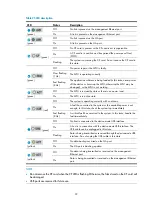
102
Table 33
RJ-45 MDI interface pinouts
Pin
10Base-T/100Base-TX
1000Base-T
Signal Function
Signal
Function
1
Tx+
Send data
BIDA+
Bi-directional data cable A+
2
Tx-
Send data
BIDA-
Bi-directional data cable A-
3
Rx+
Receive data
BIDB+
Bi-directional data cable B+
4 Reserved N/A
BIDC+ Bi-directional data cable C+
5 Reserved N/A
BIDC- Bi-directional data cable C-
6
Rx-
Receive data
BIDB-
Bi-directional data cable B-
7 Reserved N/A
BIDD+ Bi-directional data cable D+
8 Reserved N/A
BIDD- Bi-directional data cable D-
Table 34
RJ-45 MDI-X interface pinouts
Pin
10Base-T/100Base-TX
1000Base-T
Signal Function
Signal
Function
1
Rx+
Receive data
BIDB+
Bi-directional data cable B+
2
Rx-
Receive data
BIDB-
Bi-directional data cable B-
3
Tx+
Send data
BIDA+
Bi-directional data cable A+
4 Reserved
N/A
BIDD+ Bi-directional data cable D+
5 Reserved
N/A
BIDD- Bi-directional data cable D-
6
Tx-
Send data
BIDA-
Bi-directional data cable A-
7 Reserved
N/A
BIDC+ Bi-directional data cable C+
8 Reserved
N/A
BIDC- Bi-directional data cable C-
To ensure normal communication, the pins for sending data on one port should correspond to the pins for
receiving data on the peer port. When both of the ports on the two devices are MDI or MDIX, a crossover
Ethernet cable is needed. A crossover cable connects devices of the same type. When one port is MDI
and the other is MDIX, a straight-through Ethernet cable is needed. A straight-through cable connects
devices of different types.
An RJ-45 Ethernet interface with MDI/MDIX autosensing enabled can automatically negotiate pin roles.
The F5000-A5 RJ-45 Ethernet interfaces support MDI/MDIX. By default, MDI/MDIX is enabled on a
port.
Making an Ethernet twisted pair cable
1.
Cut the cable to length with the crimping pliers.
2.
Strip off an appropriate length of the cable sheath. The length is typically that of the RJ-45
connector.










































